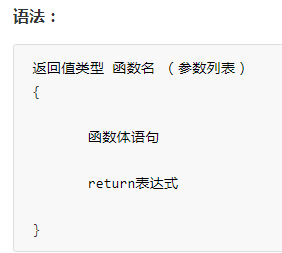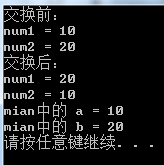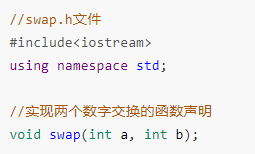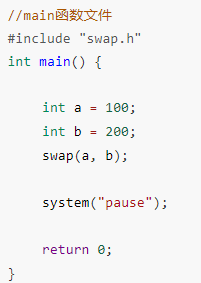概述
作用:将一段经常使用的代码封装起来,减少重复代码
一个较大的程序,一般分为若干个程序块,每个模块实现特定的功能。
函数的定义
函数的定义一般主要有5个步骤:
1、返回值类型
2、函数名
3、参数表列
4、函数体语句
5、return 表达式

#include <iostream>
using namespace std;
//函数定义
int add(int num1, int num2) //定义中的num1,num2称为形式参数,简称形参
{
int sum = num1 + num2;
return sum;
}
int main() {
int a = 10;
int b = 10;
//调用add函数
int sum = add(a, b);//调用时的a,b称为实际参数,简称实参
cout << "sum = " << sum << endl;
a = 100;
b = 100;
sum = add(a, b);
cout << "sum = " << sum << endl;
system("pause");
return 0;
}
值传递
#include <iostream>
using namespace std;
void swap(int num1, int num2)
{
cout << "交换前:" << endl;
cout << "num1 = " << num1 << endl;
cout << "num2 = " << num2 << endl;
int temp = num1;
num1 = num2;
num2 = temp;
cout << "交换后:" << endl;
cout << "num1 = " << num1 << endl;
cout << "num2 = " << num2 << endl;
//return ; 当函数声明时候,不需要返回值,可以不写return
}
int main() {
int a = 10;
int b = 20;
swap(a, b);
cout << "mian中的 a = " << a << endl;
cout << "mian中的 b = " << b << endl;
system("pause");
return 0;
}
![]()
函数的常见样式
常见的函数样式有4种
-
无参无返
-
有参无返
-
无参有返
-
有参有返
//函数常见样式
//1、 无参无返
void test01()
{
//void a = 10; //无类型不可以创建变量,原因无法分配内存
cout << "this is test01" << endl;
//test01(); 函数调用
}
//2、 有参无返
void test02(int a)
{
cout << "this is test02" << endl;
cout << "a = " << a << endl;
}
//3、无参有返
int test03()
{
cout << "this is test03 " << endl;
return 10;
}
//4、有参有返
int test04(int a, int b)
{
cout << "this is test04 " << endl;
int sum = a + b;
return sum;
}函数的声明
作用: 告诉编译器函数名称及如何调用函数。函数的实际主体可以单独定义。
-
函数的声明可以多次,但是函数的定义只能有一次
#include <iostream>
using namespace std;
//声明可以多次,定义只能一次
//声明
int max(int a, int b);
int max(int a, int b);
//定义
int max(int a, int b)
{
return a > b ? a : b;
}
int main() {
int a = 100;
int b = 200;
cout << max(a, b) << endl;
system("pause");
return 0;
}
![]()
函数的分文件编写
作用:让代码结构更加清晰
函数分文件编写一般有4个步骤
-
创建后缀名为.h的头文件
-
创建后缀名为.cpp的源文件
-
在头文件中写函数的声明
-
在源文件中写函数的定义



最后
以上就是发嗲海燕最近收集整理的关于函数||值传递||函数的常见样式||函数的声明||函数的分文件编写的全部内容,更多相关函数||值传递||函数内容请搜索靠谱客的其他文章。
本图文内容来源于网友提供,作为学习参考使用,或来自网络收集整理,版权属于原作者所有。
![[黑马程序员C++笔记]P24-P30选择结构P24程序流程结构-选择结构-单行if语句P25程序流程结构-选择结构-多行if语句P26程序流程结构-选择结构-多条件if语句P27程序流程结构-选择结构-嵌套if语句P28程序流程结构-选择案例结构-三只小猪称体重P29程序流程结构-选择结构案例-三目运算符](https://file2.kaopuke.com:8081/files_image/reation/bcimg12.png)







发表评论 取消回复